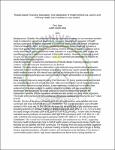| dc.description.abstract | Background: Globally, Results-Based Financing consists of monetary or non-monetary transfers made to national or subnational governments, managers, providers, or consumers of health services contingent on verified attainment of predefined results within the context of Maternal Child and Newborn Health. In Uganda, monitoring of Results-Based Financing activities at lower level public health facilities in Lira district, involves the use of quality assessment tool to verify performance against predefined health indicators on a quarterly basis. Both quality and quantitiy scores are to determine payment of the health workers. However, no attempt is made towards the assessment of health workers’ motivation and their job satisfaction in realation to results-based financing programs.
Overall Objective: To assess the contributions of Results-Based Financing strategy on health workers’ motivation and job satisfaction in Lira District
Method: The study design was a descriptive cross-sectional using mixed-method approaches Systematic random sampling technique using lottery method was used to sample the professional health workers where the Kth interval was obtained by dividing the N by the sample size. Purposive sampling technique was used to sample the health administrators as key informants of the study.
Data analysis: Data were analyzed using STATA version 17. Every questionnaire was checked for completeness at the end of each interview. Data were scanned for out-of-range and missing values before commencing data analysis. Linear regression analysis was run and then data analyzed as; Univariate analysis to analyze categorical variables and was presented in percentages and frequencies. Bivariate analysis to model the relationship between the
independent variables and the dependent variable was also carried out using limear regression. The results were expressed at 95% confidence interval and statistical significance set at a P-value of 0.05.
Results: Results of the study indicated that 50.4% of health workers were satisfied with their current job and close to half (49.6%) were dissatisfied. The overall motivation score of health workers in this study was 59.9%. The results show that the predictors of job satisfaction were providing autonomy in decision making at facility level (aOR 4.68, 95% CI: 2.21-7.15; p<0.001) and rapid changes at facility (aOR 2.93, 95% CI: 1.37-4.47; p<0.001) . Further still, the findings indicated that the predictors of motivation were age of the participant (aOR 2.53, 95% CI: 1.26-3.80; p<0.001) and enchaning support supervison (aOR 2.67, 95% CI: 1.42-3.94; p<0.001).
Conclusion: The overall level of health professionals’ job satisfaction was 50.4%, suggesting that many health professionals close to half of health workers at lower level primary health care facilities are not satisfied with their current job. The findings from this study provided suggestive evidence that the two autonomy in decision making at facility level and rapid changes at facility became important predictors of health workers’ job satisfaction at the backdrop of lira district’s current health system reform. Age of the respondents was found to be a strong predictor of
motivation among health workers additionally, enchaning support supervison was a predictor of motivation among health workers. This suggests that supportive supervision increases health worker motivation, including performance and quality of care. The study recommends that the management of the health care facilities should determine the provide incentives that the health workers are interested in. This would motivate the healthcare workers since they are provided with what they need. | en_US |

